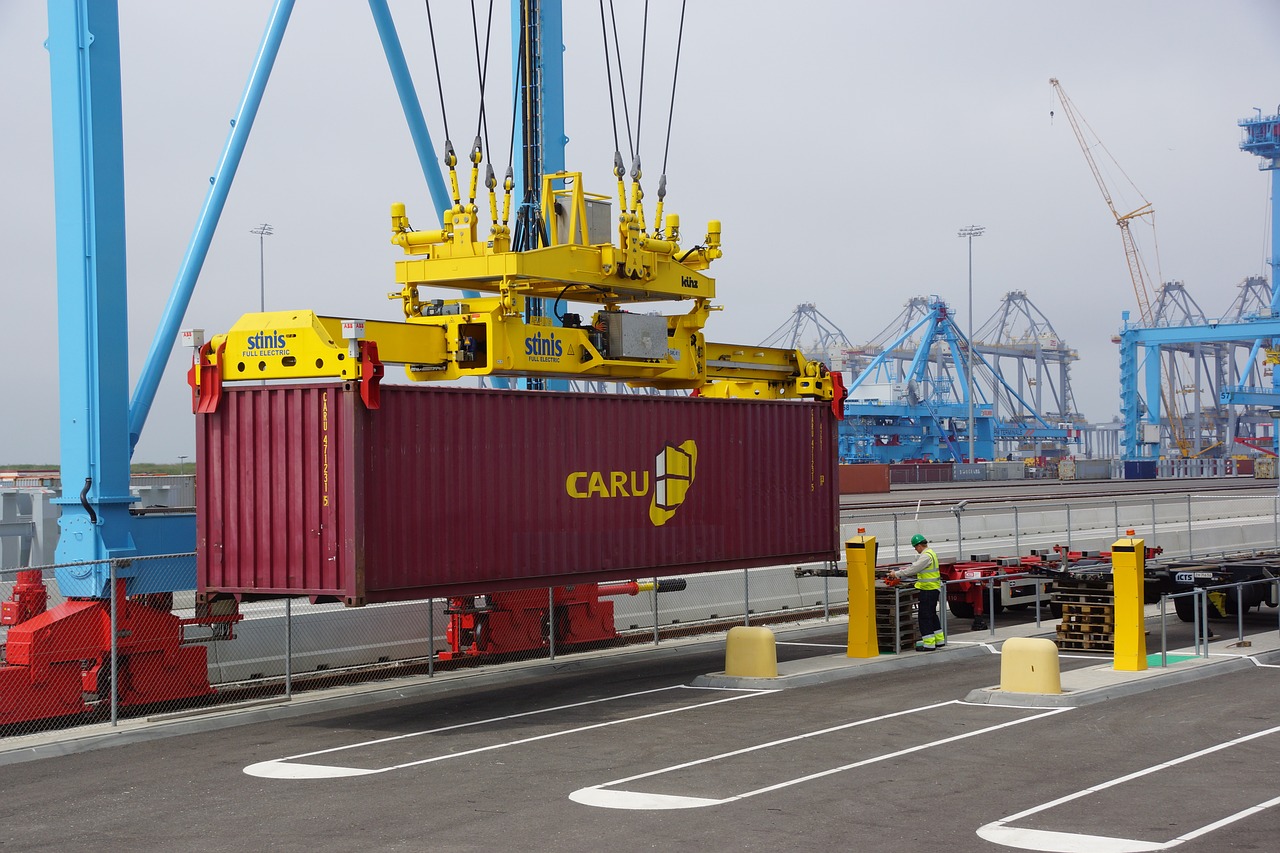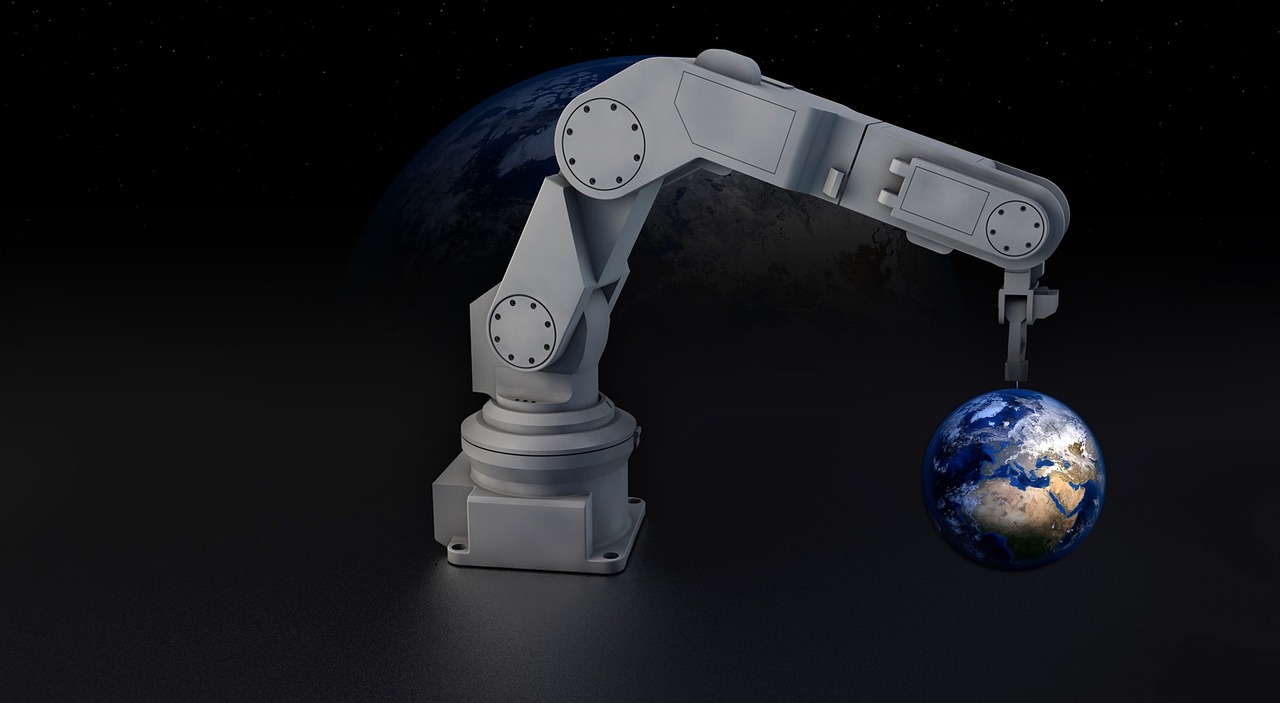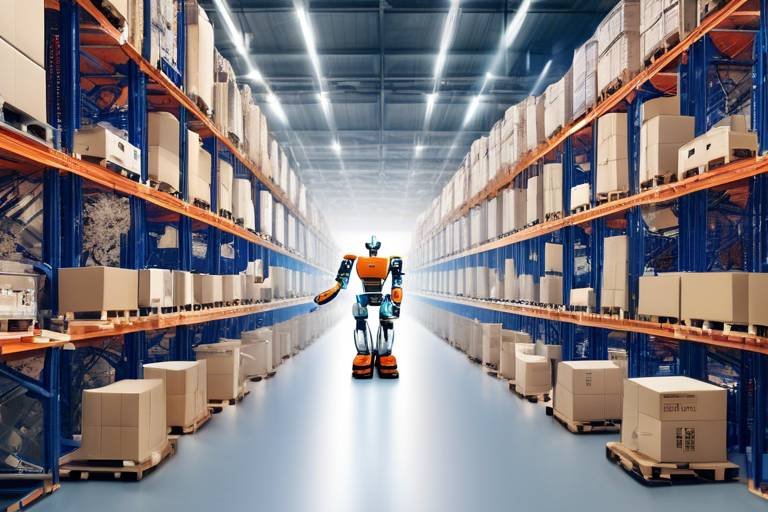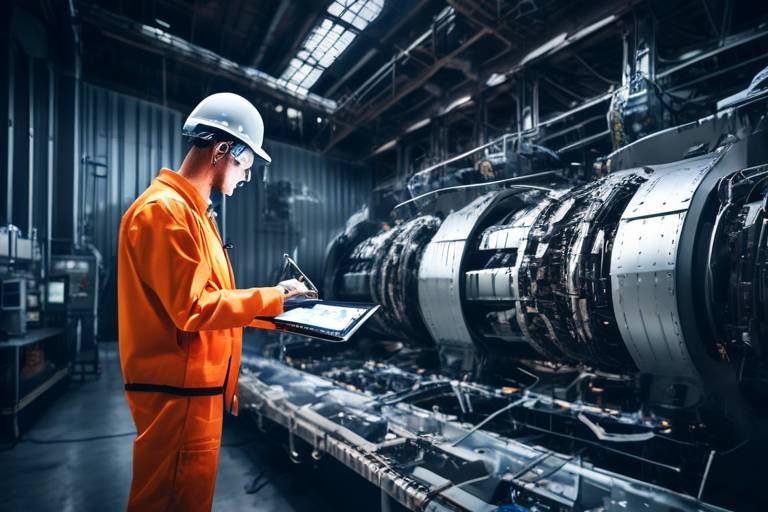How Robotics is Transforming Supply Chain Logistics
The world of supply chain logistics is undergoing a dramatic transformation, and at the heart of this revolution is robotics. As we step into an era where speed and efficiency are paramount, the integration of robotic systems is not just a trend; it's a necessity. Imagine a bustling warehouse where robots glide effortlessly, picking and packing items with precision, while human workers oversee operations from a distance. This is not science fiction—it's happening right now, and it's reshaping how we think about logistics.
So, what’s driving this shift? For starters, advancements in technology have made robotics more accessible and affordable than ever before. With the rise of artificial intelligence (AI), machine learning, and the Internet of Things (IoT), robots are becoming smarter, more efficient, and increasingly capable of handling complex tasks. This convergence of technologies is enabling logistics companies to streamline their operations, reduce costs, and improve service delivery.
But the benefits of robotics in supply chain logistics extend beyond mere efficiency. These automated systems can operate around the clock without the fatigue that human workers experience. This leads to faster processing times and quicker delivery schedules, which are crucial in today’s fast-paced market. In fact, many companies are reporting turnaround times that are significantly shorter than they were just a few years ago, thanks to robotic integration.
However, the journey towards a fully automated logistics environment is not without its challenges. Companies must navigate issues related to workforce adaptation, initial investment costs, and the ongoing maintenance of robotic systems. Yet, despite these hurdles, the potential for increased productivity and reduced operational costs makes robotics an attractive option for logistics operations worldwide.
As we look to the future, the question isn't whether robotics will play a role in supply chain logistics, but rather how extensively they will transform the industry. With continuous innovations on the horizon, the possibilities are endless. From autonomous delivery vehicles to advanced warehouse automation systems, the future of logistics is being written by robots—and it promises to be a thrilling chapter in the story of supply chain management.
Robotics has gained significant traction in supply chain logistics, driven by technological advancements. This section delves into the factors contributing to the increasing adoption of robotics in the logistics sector.
The integration of robotics in logistics offers numerous advantages, including enhanced efficiency, reduced labor costs, and increased accuracy. Here, we examine how these benefits influence supply chain operations.
Robots streamline operations, enabling faster processing and delivery times. This subsection discusses how automation enhances overall efficiency in supply chain logistics, leading to quicker turnaround times.
Real-world examples illustrate the significant efficiency gains achieved through robotic automation in various logistics operations. These case studies highlight the transformative effects of robotics on supply chain performance.
Innovations such as AI and machine learning are pivotal in enhancing robotic capabilities. This section explores how these technologies are driving advancements in logistics automation.
Implementing robotics can lead to substantial cost savings in logistics. Here, we discuss various strategies for reducing operational costs through automation and the long-term financial benefits.
Despite the benefits, integrating robotics into supply chains poses challenges. This section addresses common obstacles organizations face when adopting robotic solutions in their logistics operations.
The introduction of robotics necessitates workforce adaptation. This subsection discusses the importance of training employees to work alongside robots and the strategies for effective workforce integration.
High initial costs can deter organizations from adopting robotic solutions. Here, we explore the financial considerations and potential return on investment (ROI) associated with robotics in logistics.
As technology continues to evolve, the future of robotics in logistics looks promising. This section speculates on upcoming trends and innovations that will shape the industry in the coming years.
- What are the main benefits of using robotics in logistics?
Robotics enhances efficiency, reduces labor costs, and increases accuracy in supply chain operations. - How do robots improve processing times?
Robots can work continuously without fatigue, leading to faster processing and delivery times. - What challenges do companies face when implementing robotics?
Common challenges include workforce adaptation, high initial investment costs, and ongoing maintenance of robotic systems. - What is the future of robotics in logistics?
The future looks bright, with continuous innovations expected to further enhance efficiency and capabilities in supply chain logistics.

The Rise of Robotics in Logistics
In recent years, robotics has emerged as a game-changer in the world of supply chain logistics. The convergence of advanced technologies such as artificial intelligence, machine learning, and automation has paved the way for a new era of efficiency and productivity. Have you ever wondered how a simple robot can manage tasks that used to take hours, if not days, for humans? The answer lies in the remarkable advancements in robotics that are transforming logistics operations at an unprecedented pace.
The driving forces behind the increasing adoption of robotics in logistics are multifaceted. Firstly, the demand for faster delivery times is at an all-time high. Customers expect their orders to arrive almost instantaneously, a challenge that traditional logistics methods struggle to meet. Robotics offers a solution by streamlining processes and reducing turnaround times. For instance, automated guided vehicles (AGVs) can transport goods across warehouses without human intervention, ensuring that products are moved efficiently and swiftly.
Moreover, the ongoing labor shortages in many regions have compelled companies to seek alternative solutions. With fewer workers available, organizations are turning to robots to fill the gaps. This shift not only mitigates the impact of labor shortages but also allows human workers to focus on more complex and strategic tasks, enhancing overall productivity. Imagine a scenario where robots handle repetitive tasks while humans oversee operations and make critical decisions—this is the future that robotics promises.
Additionally, the rise of e-commerce has further accelerated the need for robotic solutions. As online shopping continues to grow, logistics companies are challenged to process and fulfill orders quickly and accurately. Robotics can significantly enhance warehouse operations, from sorting and packing to inventory management. For example, robots equipped with advanced sensors can identify and retrieve items from shelves, reducing the likelihood of errors and improving accuracy in order fulfillment.
However, the integration of robotics in logistics is not just about adopting new technology; it's also about a cultural shift within organizations. Companies must embrace a mindset that values innovation and adaptability. This transformation requires a commitment to ongoing training and development for employees, ensuring they are equipped to work alongside robots effectively.
In conclusion, the rise of robotics in logistics is driven by a combination of factors, including the demand for speed, the need to address labor shortages, and the growth of e-commerce. As companies continue to explore the potential of robotic automation, the logistics landscape is set to undergo a radical transformation, paving the way for a more efficient and productive future.

Benefits of Robotic Automation
The integration of robotics in supply chain logistics is not just a trend; it's a revolution that is reshaping the entire industry. With the rise of automation, businesses are discovering a plethora of benefits that can significantly enhance their operations. Imagine a world where goods are moved swiftly and accurately, where human error is minimized, and where costs are slashed. This is the reality that robotic automation brings to the table.
One of the most compelling advantages of robotic automation is the enhanced efficiency it offers. Robots can operate around the clock without the need for breaks, leading to improved productivity levels. For instance, consider a warehouse where robots are utilized for picking and packing. These machines can work tirelessly, reducing the time it takes to fulfill orders. As a result, businesses can achieve quicker turnaround times, which is crucial in today’s fast-paced market.
Furthermore, the accuracy of robotic systems is another significant benefit. Human workers, while skilled, can make mistakes, especially in repetitive tasks. Robots, on the other hand, are programmed to perform tasks with precision. This increased accuracy not only minimizes errors but also enhances customer satisfaction. After all, who wouldn’t appreciate receiving their orders exactly as expected? A recent study found that companies that integrated robotic systems saw a 30% reduction in order errors, leading to happier customers and fewer returns.
In addition to efficiency and accuracy, cost reduction is a critical factor driving the adoption of robotics in logistics. While the initial investment in robotic technology can be substantial, the long-term savings are undeniable. By automating repetitive tasks, companies can reduce their labor costs significantly. For example, a logistics company that implemented robotic automation reported a 25% decrease in operational costs within the first year. This is not just about saving money; it’s about reallocating resources to areas that drive growth and innovation.
Moreover, the flexibility of robotic systems adds another layer of value. Modern robots can be reprogrammed and adapted to handle different tasks as business needs change. This adaptability means that companies can scale their operations without the overwhelming costs associated with hiring and training new staff. Imagine being able to switch from handling small packages to larger freight with just a few adjustments in programming. This kind of versatility is a game-changer in the logistics sector.
To sum up, the benefits of robotic automation in supply chain logistics are profound and multifaceted. From enhanced efficiency and accuracy to significant cost reductions and unparalleled flexibility, the advantages are clear. As businesses continue to embrace this technology, the landscape of logistics will undoubtedly continue to evolve, paving the way for a future that is more efficient, effective, and customer-centric.
- What types of robots are commonly used in logistics?
Common types of robots include autonomous mobile robots (AMRs), robotic arms for picking and packing, and automated guided vehicles (AGVs) for transporting goods.
- How can small businesses benefit from robotic automation?
Small businesses can improve efficiency, reduce labor costs, and enhance accuracy in their operations, allowing them to compete more effectively with larger companies.
- Are there any downsides to implementing robotics in logistics?
Challenges include high initial costs, the need for employee training, and potential resistance to change within the workforce.

Improved Efficiency and Speed
In the fast-paced world of supply chain logistics, efficiency and speed are not just desirable; they are essential for survival. The integration of robotics into logistics operations has revolutionized the way companies manage their supply chains. Imagine a bustling warehouse where robots glide seamlessly between aisles, picking and packing items with precision that no human could match. This is not science fiction; it’s the reality of modern logistics powered by robotics.
Robots are designed to perform repetitive tasks at a speed that significantly outpaces human workers. For example, while a human might take several minutes to pick an item from a shelf, a robot can accomplish the same task in a fraction of that time. This speed not only enhances productivity but also ensures that orders are processed and shipped faster than ever before. The result? Quicker turnaround times that delight customers and keep businesses competitive.
Moreover, the implementation of robotic systems leads to a remarkable reduction in errors. When humans are tasked with repetitive tasks, fatigue can lead to mistakes, which in turn can result in costly returns and dissatisfied customers. However, robots operate with a level of consistency that eliminates these concerns. According to recent studies, warehouses that have adopted robotic automation have seen a 30% reduction in order processing errors, allowing for a smoother operational flow.
To further illustrate the impact of robotics on efficiency, let’s take a look at some key metrics from companies that have successfully integrated these technologies into their logistics operations:
| Company | Before Robotics (Orders/Hour) | After Robotics (Orders/Hour) | Error Rate (%) |
|---|---|---|---|
| Company A | 100 | 250 | 5 |
| Company B | 150 | 400 | 3 |
| Company C | 120 | 300 | 2 |
As demonstrated in the table above, the transition to robotic systems has enabled these companies to triple their order processing capabilities while simultaneously reducing error rates. This dramatic increase in efficiency is a game-changer in the logistics landscape, where meeting customer demands swiftly can make all the difference between gaining a loyal customer and losing them to a competitor.
In addition to enhancing speed and accuracy, robotics also allows for better utilization of warehouse space. Robots can navigate tight spaces and reach higher shelves, maximizing storage capacity. This means that businesses can store more products without needing to expand their physical footprint, leading to significant cost savings in real estate and operations.
In conclusion, the integration of robotics into supply chain logistics is not merely an upgrade; it’s a transformation that drives efficiency and speed to unprecedented heights. As technology continues to advance, we can expect even more innovations that will further enhance these capabilities, making logistics operations faster, more accurate, and ultimately more profitable.

Case Studies of Efficiency Gains
The integration of robotics into supply chain logistics is not just a theoretical concept; it has been successfully implemented in various companies, showcasing remarkable efficiency gains. One standout example is Amazon, which has revolutionized its warehouse operations through the use of robotic systems. By employing Kiva robots, Amazon has streamlined its order fulfillment process, allowing for a staggering 50% increase in productivity. These robots work collaboratively with human employees, moving items around the warehouse, which significantly reduces the time spent on manual labor.
Another compelling case study can be observed in the operations of DHL, a global leader in logistics. DHL implemented autonomous mobile robots (AMRs) in their warehouses, which enabled them to manage inventory more effectively. The result? A 30% reduction in order processing time. This not only improved the speed at which orders were fulfilled but also enhanced accuracy, reducing the number of errors in shipments. The AMRs navigate through the warehouse using advanced sensors and AI, ensuring that they can operate safely alongside human workers.
Furthermore, Walmart has also embraced robotics in its supply chain logistics. The retail giant has introduced robotic systems for inventory management in their stores. These robots scan shelves to check stock levels, ensuring that items are always available for customers. This initiative has led to a 20% decrease in stockouts, ultimately improving customer satisfaction and increasing sales. The robots provide real-time data, allowing Walmart to make informed decisions about restocking and inventory management.
To illustrate the impact of these case studies, here’s a table summarizing the efficiency gains achieved by these companies:
| Company | Robotic Technology Used | Efficiency Gain |
|---|---|---|
| Amazon | Kiva Robots | 50% increase in productivity |
| DHL | Autonomous Mobile Robots (AMRs) | 30% reduction in order processing time |
| Walmart | Inventory Management Robots | 20% decrease in stockouts |
These case studies not only highlight the transformative power of robotics in logistics but also serve as a beacon for other companies considering similar integrations. The results speak volumes: improved efficiency, reduced labor costs, and enhanced accuracy are just the tip of the iceberg. As more organizations recognize the potential of robotic automation, we can expect to see a significant shift in how logistics operations are conducted across the globe.
- What are the main benefits of using robotics in supply chain logistics?
Robotics enhances efficiency, reduces labor costs, and increases accuracy in logistics operations. - Are there any challenges in implementing robotics?
Yes, challenges include workforce adaptation, initial investment costs, and the need for employee training. - How do robots improve efficiency in logistics?
Robots streamline operations, reduce processing times, and minimize errors, leading to faster delivery and improved service. - What is the future of robotics in supply chain logistics?
The future looks promising with advancements in AI, machine learning, and continued integration of robotics into logistics operations.

Technological Innovations Driving Change
The logistics industry is undergoing a remarkable transformation, largely fueled by technological innovations that are redefining how we think about supply chain operations. At the heart of this revolution are advancements in Artificial Intelligence (AI), machine learning, and robotics. These technologies are not just enhancing existing processes; they are creating entirely new paradigms in logistics management. Imagine a world where warehouses operate like well-oiled machines, with robots working alongside humans to optimize every aspect of logistics. This is not just a dream; it’s becoming a reality thanks to these innovations.
One of the most significant contributions of AI in logistics is its ability to analyze vast amounts of data in real-time. This capability allows companies to make informed decisions quickly, improving responsiveness to market changes. For instance, AI algorithms can predict demand trends, enabling better inventory management and reducing the risk of overstocking or stockouts. When combined with robotics, this leads to a more agile supply chain, where products can be moved and delivered faster than ever before.
Moreover, machine learning plays a crucial role in enhancing the efficiency of robotic systems. By learning from past experiences, robots can optimize their own performance over time. This self-improvement capability means that the longer a robot operates, the better it becomes at its tasks, whether that’s picking items from shelves or navigating complex warehouse layouts. Picture this: a robot that learns to avoid obstacles and streamline its path, reducing delivery times and improving overall operational efficiency.
Another exciting innovation is the use of Internet of Things (IoT) technology in logistics. IoT devices can collect and transmit data from various points in the supply chain, providing real-time visibility into operations. This connectivity allows for better tracking of goods and equipment, enhancing transparency and accountability. For example, sensors on delivery trucks can monitor temperature and humidity, ensuring that sensitive products are transported under optimal conditions. This level of monitoring not only safeguards product quality but also builds trust with customers.
Finally, the advent of autonomous vehicles is set to revolutionize logistics even further. Imagine fleets of self-driving trucks and drones delivering packages to your doorstep without human intervention. These vehicles can operate around the clock, significantly reducing delivery times and costs. While this technology is still in its infancy, the potential it holds for the future of logistics is staggering. Companies are already investing heavily in research and development to bring these innovations to the forefront.
In summary, the integration of AI, machine learning, IoT, and autonomous vehicles is driving a wave of change in supply chain logistics. These technologies are not just tools; they are catalysts for a new era of efficiency, speed, and reliability in logistics operations. As we continue to embrace these innovations, we can expect to see a logistics landscape that is more responsive, cost-effective, and aligned with the demands of the modern consumer.
- What role does AI play in logistics?
AI helps analyze data for better decision-making and improves demand forecasting, leading to more efficient inventory management. - How do robotics and automation affect job opportunities?
While some jobs may be displaced, robotics also creates new roles focused on managing and maintaining these technologies. - What are the benefits of using IoT in logistics?
IoT enhances visibility and tracking of goods, improving transparency and operational efficiency. - Are autonomous vehicles safe for logistics operations?
Safety is a priority, and ongoing research and testing aim to ensure that autonomous vehicles can operate safely in various environments.

Cost Reduction Strategies
Implementing robotics in supply chain logistics is not just about enhancing efficiency; it's also a powerful strategy for cost reduction. As companies grapple with rising operational expenses, the allure of automation becomes increasingly attractive. But how exactly does robotic integration help in slashing costs? Let's explore some of the most effective strategies that organizations can adopt.
First and foremost, one of the most significant ways robotics can cut costs is through labor savings. Traditional logistics operations require a large workforce to manage tasks such as picking, packing, and shipping. By introducing robots into these workflows, companies can reduce their reliance on human labor. This doesn't mean that jobs will disappear; rather, it allows the workforce to focus on more complex, value-added tasks. For instance, while robots handle repetitive tasks, employees can engage in quality control and customer service, enhancing overall productivity.
Another key area where robotics shines is in inventory management. Advanced robotic systems equipped with AI can track inventory levels in real-time, predicting shortages and preventing overstock situations. This capability not only reduces waste but also ensures that companies maintain optimal stock levels, which is crucial for minimizing storage costs. When inventory is managed effectively, businesses can avoid the expenses associated with excess stock and the risk of stockouts that can lead to lost sales.
Moreover, the speed of operations plays a critical role in cost reduction. Robots can operate around the clock without fatigue, leading to faster processing times. This efficiency translates into quicker turnaround times for orders, allowing companies to fulfill customer demands promptly. In a world where customers expect instant gratification, being able to deliver products faster than competitors can significantly enhance a company's market position and profitability.
To illustrate the financial impact of robotic automation, consider the following table:
| Cost Factor | Traditional Method | Robotic Automation |
|---|---|---|
| Labor Costs | $100,000/year | $60,000/year |
| Inventory Holding Costs | $50,000/year | $30,000/year |
| Operational Downtime | 20% | 5% |
As seen in the table, companies can save significantly on labor and inventory costs while also reducing downtime, which is crucial for maintaining operational efficiency. These savings can be reallocated to other areas of the business, such as research and development or marketing, driving further growth.
Lastly, while the initial investment in robotics may seem daunting, the long-term financial benefits often outweigh these upfront costs. Many organizations find that the return on investment (ROI) from robotic automation can be realized within a few years. By continuously monitoring performance metrics and adjusting strategies accordingly, businesses can ensure that they maximize their investment in robotics.
In conclusion, adopting robotics in supply chain logistics is more than just a trend; it's a strategic move that can lead to substantial cost reductions. By focusing on labor savings, efficient inventory management, and operational speed, companies can not only cut costs but also position themselves for future success in an increasingly competitive market.
Q1: What are the initial costs associated with implementing robotics in logistics?
A1: Initial costs can vary widely depending on the technology and scale of implementation. However, businesses should consider long-term savings and ROI when evaluating these costs.
Q2: Will robotics eliminate jobs in the logistics sector?
A2: While some repetitive jobs may be automated, robotics often leads to a shift in job roles, allowing employees to focus on more complex tasks that require human oversight.
Q3: How do robots improve inventory management?
A3: Robots equipped with AI can provide real-time inventory tracking, helping businesses maintain optimal stock levels and reduce waste.
Q4: What is the expected ROI for robotic automation in logistics?
A4: Many companies report a positive ROI within a few years of implementing robotic systems, thanks to reduced labor costs and improved operational efficiency.

Challenges in Implementing Robotics
As exciting as the integration of robotics into supply chain logistics may be, it doesn't come without its fair share of challenges. Picture this: you’re a logistics manager eager to embrace the future with robotic automation, but suddenly you’re faced with the reality of hurdles that could slow down your ambitious plans. The journey to a fully automated warehouse isn’t just a walk in the park; it's more like navigating through a complex maze. Let's take a closer look at the hurdles organizations encounter when trying to implement robotics.
One of the most pressing challenges is the need for workforce adaptation and training. While robots can handle repetitive tasks with ease, human workers must learn to collaborate with these machines effectively. This requires a shift in mindset. Employees may feel threatened by the introduction of automation, fearing job loss or redundancy. To counter this, organizations must invest in comprehensive training programs that not only teach employees how to work alongside robots but also highlight the benefits of automation. This approach can turn apprehension into enthusiasm, fostering a culture of innovation rather than fear.
Another significant obstacle is the initial investment and ROI concerns. The upfront costs associated with acquiring robotic systems can be daunting. Many companies may hesitate to dive into automation, fearing that they won't see a return on their investment. It’s crucial for organizations to conduct thorough cost-benefit analyses to understand the long-term financial advantages of robotic solutions. For instance, while the initial investment might be high, the potential savings from reduced labor costs and increased efficiency can lead to a positive ROI over time. Below is a simplified table illustrating potential costs versus savings:
| Cost Category | Estimated Initial Investment | Projected Annual Savings |
|---|---|---|
| Robotic Systems | $500,000 | $200,000 |
| Training Programs | $50,000 | $10,000 |
| Maintenance and Upkeep | $20,000 | N/A |
| Total | $570,000 | $210,000 |
Moreover, the integration of new technologies into existing systems can be a daunting task. Many organizations have legacy systems that may not easily accommodate new robotic solutions. This can lead to compatibility issues and require additional investments in software and hardware. The key here is to approach integration strategically, ensuring that any new technology works seamlessly with what’s already in place. This might mean a phased implementation where robots are introduced gradually, allowing time for adjustments and minimizing disruptions.
Lastly, there’s the challenge of maintaining robotic systems. Just like any piece of equipment, robots require regular maintenance to ensure they function optimally. Organizations need to have a plan in place for ongoing support and repairs, as downtime can be costly. This means not only budgeting for maintenance costs but also having skilled technicians on hand to address any issues that arise.
In conclusion, while the road to implementing robotics in supply chain logistics is fraught with challenges, these obstacles can be overcome with the right strategies and mindset. By investing in training, conducting thorough financial analyses, planning for technology integration, and ensuring proper maintenance, organizations can set themselves up for success in this new era of logistics.
- What are the primary challenges of implementing robotics in logistics? The main challenges include workforce adaptation, initial investment costs, integration with existing systems, and maintenance requirements.
- How can organizations prepare their workforce for robotic integration? Organizations can prepare their workforce by offering comprehensive training programs that emphasize collaboration and the benefits of working with robots.
- Is the initial investment in robotics worth it? Yes, while the upfront costs can be high, the long-term savings and efficiency gains often lead to a positive return on investment.

Workforce Adaptation and Training
As robotics continues to infiltrate the logistics sector, one of the most pressing challenges organizations face is workforce adaptation. The introduction of automated systems and robotic solutions isn't just a matter of installing new machines; it's about creating a harmonious working environment where humans and robots can collaborate effectively. Imagine a symphony orchestra where every instrument must play in harmony to create beautiful music. In the logistics world, the human workforce and robotic systems must also work together seamlessly to achieve operational excellence.
Training becomes crucial in this context. Employees need to be equipped with the skills to operate alongside robots, understand their functionalities, and troubleshoot any issues that may arise. It's not just about teaching them how to use the technology; it's about fostering a mindset that embraces change and innovation. Companies can implement training programs that focus on both technical skills and soft skills, such as teamwork and communication. For instance, a logistics company might offer workshops that combine hands-on training with theoretical knowledge about robotic systems.
Moreover, organizations can benefit from adopting a continuous learning approach. As technology evolves, so too should the skills of the workforce. This approach includes regular training sessions, online courses, and even partnerships with educational institutions. By doing so, companies ensure their employees are not left behind in the rapidly changing landscape of logistics. According to a recent study, companies that invest in employee training see a 20% increase in productivity within the first year of implementation, showcasing the tangible benefits of a well-trained workforce.
Another important aspect of workforce adaptation is addressing the psychological impact of automation. Employees may feel threatened by the introduction of robotics, fearing job loss or redundancy. To mitigate these concerns, open communication is key. Organizations should engage their employees in discussions about the benefits of robotics, emphasizing how these technologies can enhance their roles rather than replace them. For example, robots can take over repetitive, mundane tasks, allowing employees to focus on more strategic and fulfilling responsibilities.
In conclusion, workforce adaptation and training are not just supplementary to the integration of robotics in logistics; they are essential components that ensure success. By investing in comprehensive training programs and fostering a culture of continuous learning, organizations can create a future-ready workforce that thrives alongside automated systems.
- What skills are essential for employees to work alongside robots? Employees should focus on technical skills related to robotics, as well as soft skills like teamwork and problem-solving.
- How can organizations address employee fears about automation? Open communication about the benefits of robotics and how they enhance roles can help alleviate concerns.
- What type of training programs are most effective? A combination of hands-on training, workshops, and online courses tends to be the most effective for employee training.
- Is continuous learning important in a robotics-driven environment? Absolutely! Continuous learning ensures that employees keep up with technological advancements and remain valuable to the organization.

Initial Investment and ROI Concerns
When it comes to integrating robotics into supply chain logistics, one of the most pressing issues that organizations face is the initial investment. The cost of purchasing, implementing, and maintaining robotic systems can be daunting. Many companies find themselves hesitating at the starting line, wondering if the financial outlay is worth the potential benefits. It's like buying a fancy sports car; you know it can take you places faster, but the price tag can make you second-guess your decision.
To truly understand the impact of this investment, businesses need to look beyond the upfront costs. A well-planned implementation of robotics can lead to significant long-term savings. In fact, studies show that companies that have successfully integrated robotics into their logistics operations often see a return on investment (ROI) within a few years. However, this return isn't just about the immediate savings; it encompasses various factors, including:
- Increased Productivity: Robots can operate continuously without the need for breaks, leading to higher output.
- Labor Cost Reduction: While the initial investment in robots can be high, the long-term savings on labor costs can be substantial.
- Minimized Errors: Automation reduces human error, which can save money on returns and rework.
To illustrate this point, let’s take a look at a hypothetical scenario:
| Year | Initial Investment | Annual Savings | Cumulative ROI |
|---|---|---|---|
| 1 | $500,000 | $100,000 | -80% |
| 2 | $0 | $150,000 | -30% |
| 3 | $0 | $200,000 | 40% |
| 4 | $0 | $250,000 | 90% |
As shown in the table, while the first year might look bleak with a significant initial investment, the subsequent years reveal a different story. By the third year, the ROI turns positive, and by the fourth year, the cumulative savings make the investment worthwhile. This is a crucial aspect for organizations to consider as they weigh the pros and cons of robotic integration.
Another concern that often arises is the ongoing maintenance costs associated with robotic systems. These costs can vary widely depending on the complexity of the technology and the level of support required. However, many companies find that the benefits of reduced labor costs and increased efficiency far outweigh these ongoing expenses. It's essential for businesses to conduct a thorough cost-benefit analysis before making a decision, ensuring they account for both direct and indirect costs.
In conclusion, while the initial investment and ROI concerns can be significant hurdles in adopting robotics for supply chain logistics, the long-term benefits can be transformative. Companies that take the plunge often find themselves reaping the rewards in terms of efficiency, productivity, and cost savings. The key is to approach this investment with a clear strategy and realistic expectations, ensuring that they are prepared to navigate the challenges and celebrate the victories that come with robotic automation.
Q1: How long does it typically take to see a return on investment from robotics in logistics?
A1: While it varies by organization and implementation, many companies report seeing a positive ROI within three to five years after integrating robotic systems.
Q2: Are there any hidden costs associated with robotic automation?
A2: Yes, aside from the initial purchase price, companies should consider ongoing maintenance, training, and potential upgrades as part of their total cost of ownership.
Q3: Can small businesses afford robotic solutions?
A3: Many robotic solutions are now scalable and can be tailored to fit the budget of smaller businesses. Additionally, there are leasing options available that can make robotics more accessible.

The Future of Robotics in Supply Chain Logistics
As we look ahead, the future of robotics in supply chain logistics is not just bright; it's practically glowing with potential. The rapid pace of technological advancement is set to revolutionize the logistics sector, making it more efficient and responsive to the ever-changing demands of the market. Imagine a world where warehouses are fully automated, where robots and humans work in perfect harmony, and where delivery times are slashed to mere hours. Sounds like science fiction, right? But it's closer than you think!
One of the most exciting trends on the horizon is the integration of artificial intelligence (AI) and machine learning with robotics. These technologies are not just buzzwords; they are the backbone of the next generation of logistics solutions. With AI, robots can learn from their environment, adapt to new situations, and make decisions on the fly. This means less downtime, more accurate inventory management, and enhanced customer satisfaction. For example, imagine a robot that can predict stock shortages before they happen, automatically reordering supplies to keep operations running smoothly.
Furthermore, the advent of autonomous vehicles is set to shake things up even further. Picture self-driving trucks navigating highways and drones delivering packages to your doorstep. These innovations promise to reduce transportation costs significantly while increasing delivery speed. According to industry experts, logistics companies that embrace autonomous technology could see a reduction in operational costs by up to 30% over the next decade. That's a game-changer!
However, with great power comes great responsibility. As robotics technology advances, companies will need to address concerns regarding data security and privacy. With robots collecting and processing vast amounts of data, ensuring that this information is protected from cyber threats will be paramount. Organizations must invest in robust cybersecurity measures to safeguard their operations and maintain customer trust.
In addition to technological advancements, the workforce will also need to evolve. As robots take on more tasks, there will be a growing demand for skilled workers who can manage and maintain these sophisticated systems. Companies will need to invest in training programs that equip employees with the necessary skills to thrive in an increasingly automated environment. This is not just about replacing jobs; it’s about creating new opportunities for growth and development.
To summarize, the future of robotics in supply chain logistics is poised for transformation through:
- AI and Machine Learning: Enhancing decision-making and operational efficiency.
- Autonomous Vehicles: Reducing costs and improving delivery times.
- Cybersecurity Measures: Protecting data and maintaining customer trust.
- Workforce Development: Training employees for new roles in a tech-driven environment.
As we navigate this exciting landscape, it's clear that robotics will play a crucial role in shaping the future of supply chain logistics. The key will be to embrace these changes, adapt to new technologies, and ensure that both businesses and employees are equipped to thrive in this new era. The journey ahead is sure to be filled with challenges, but the rewards for those who innovate and adapt will be immense.
1. What role will AI play in logistics robotics?
AI will enhance the capabilities of logistics robots, enabling them to learn from their environments and make real-time decisions, which will improve efficiency and accuracy.
2. How will autonomous vehicles impact the logistics industry?
Autonomous vehicles are expected to reduce transportation costs and delivery times significantly, making logistics operations more efficient.
3. What are the cybersecurity concerns associated with robotics in logistics?
As robots collect and process large amounts of data, protecting this information from cyber threats will be crucial for maintaining operational integrity and customer trust.
4. Will robotics lead to job losses in the logistics sector?
While some jobs may be automated, robotics will also create new roles that require skilled workers to manage and maintain these technologies.
Frequently Asked Questions
- What are the main benefits of using robotics in supply chain logistics?
The integration of robotics in supply chain logistics offers a multitude of benefits. Primarily, it enhances efficiency by streamlining operations, which leads to faster processing and delivery times. Additionally, robotic automation can significantly reduce labor costs and increase accuracy in inventory management, minimizing human errors. Overall, these advantages contribute to a more productive supply chain.
- How does robotic automation improve efficiency?
Robots are designed to handle repetitive tasks with precision and speed, which accelerates the entire logistics process. For instance, they can quickly sort, pack, and transport goods, reducing the time it takes to fulfill orders. This increased speed not only enhances customer satisfaction but also allows companies to handle larger volumes of work without compromising quality.
- What challenges do companies face when implementing robotics?
While the benefits are substantial, companies often encounter challenges such as the need for workforce adaptation and training. Employees must learn to work alongside robots, which can require significant investment in training programs. Additionally, the initial investment in robotic technology can be high, leading to concerns about the return on investment (ROI) before the benefits are fully realized.
- What technological innovations are driving robotic advancements?
Technological innovations such as artificial intelligence (AI) and machine learning are at the forefront of enhancing robotic capabilities in logistics. These technologies enable robots to learn from their environment, make real-time decisions, and adapt to changing conditions, which is crucial for improving overall operational efficiency.
- What does the future hold for robotics in supply chain logistics?
The future of robotics in supply chain logistics is incredibly promising. As technology continues to evolve, we can expect to see even more advanced robotic systems that are capable of handling complex tasks autonomously. Innovations such as autonomous vehicles and smart warehouses will likely reshape the logistics landscape, making operations more efficient and responsive to market demands.



















